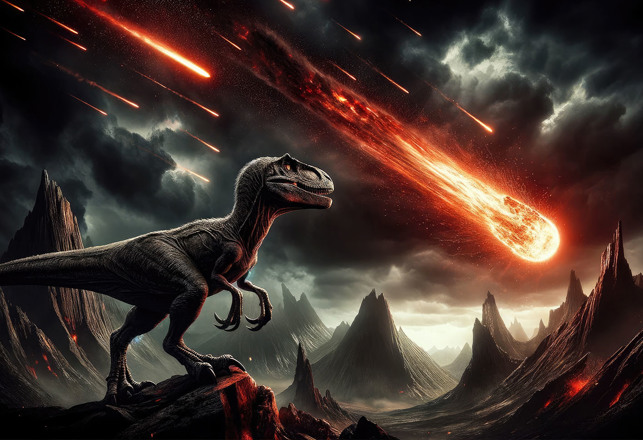The concept that human civilization has been regularly evolving over time in a linear method, is a comparatively new idea that was formulated throughout the interval of colonization. Practically each historical tradition believed in any other case. They mentioned that point strikes in cycles, smaller and bigger, and that our civilization has gone by innumerable ups and downs over eons. With the emergence of latest scientific knowledge, it’s turning into more and more apparent that the ancients knew what they have been speaking about, and we have now been far too fast to denounce the collective knowledge of our ancestors because the flights of fancy of primitives.
The idea of the Yuga Cycle or the Nice 12 months was identified to most historical cultures, and, as per this framework, we have now devolved from an erstwhile Golden Age of illumination, concord and abundance to the present age of greed and lies, discord and shortage. The elemental issue that differentiates the next age from a decrease one is the state of man’s consciousness. In a Golden Age, consciousness is so elevated and purified, that we are able to simply comprehend the mysteries of creation, and of our place within the wider scheme of issues, and, thus, we’re in a position to lead lengthy lives in a state of pleasure, stability and concord. For the reason that setting displays our state of consciousness, there’s fertility and abundance within the larger ages and a scarcity of illnesses and pure disasters. However as we devolve alongside the descending arc of the Yuga Cycle or Nice 12 months, we transfer from soul consciousness to ego consciousness, accompanied by a degradation in our bodily measurement and the exterior setting, which regularly results in a burgeoning of violence, distress and discontent in society.
What is absolutely putting is that every one of those claims at the moment are being borne out by scientific findings from totally different disciplines. It seems that, over the previous 12,000 years of the descending arc of the Yuga Cycle, people have shrunk in measurement by no less than 10%, together with a corresponding decline in bone energy and athleticism. This has been accompanied by a ten% to 17% discount in our cranial quantity over the identical interval, which has not solely diminished the typical mind however decreased our reminiscence and atrophied our sense of judgment and morality, together with a bunch of refined psychological talents resembling foresight, telepathy and so on. And so as to add to those stunning statistics, it seems that, in the direction of the top of the final Ice Age, there was no meals shortage or illnesses, however as time went on, meals sources grew to become scarce, many sorts of illnesses grew to become endemic, and incidences of violent deaths elevated considerably.
The whole lot that the ancients mentioned in regards to the Yuga Cycle or Nice 12 months is now turning out to be info, however why aren’t these statistics being mentioned on mainstream media shops? It’s as a result of they run counter to the Darwinian fable of gradual evolution by pure choice that has been actually shoved down our throats and become an incontrovertible dogma. Only a few scientists, teachers or media channels will dare to query Darwinism, for worry of getting ridiculed, denied funds or promotions, and even hounded out of their career. Don’t query the science, is the present science. This, sadly, is the insidious method during which issues work within the Kali Yuga, the darkest age of human historical past.
In my ebook, Yuga Shift, I’ve introduced what I imagine is the unique Yuga Cycle framework. It’s of the identical period because the precessional cycle of the earth, i.e. 25,800 years, and contains an ascending cycle of consciousness and a descending cycle of consciousness, that are separated by two prolonged durations of transition that the Greeks known as Kataklysmos (which means “Deluge”) or the “nice winter” of the Nice 12 months, and Ekpyrosis (which means “Conflagration”) or the “nice summer time” of the Nice 12 months.
It’s the interval of Ekpyrosis that we’re heading in the direction of, because the Kali Yuga and the whole descending cycle of consciousness come to an finish in 2025.
A Day and Night time of Brahma
One of many ideas that come to thoughts after we take into consideration the Yuga Cycle or the Cycle of the Ages is that, does it proceed indefinitely, with none starting or finish, or is it a part of a good bigger cycle of time.
As per the traditional Vedic texts, there’s a good longer cycle of time known as the “Day and Night time of Brahma”, which extends for a whopping 25.8 million years! It consists of a “Day of Brahma” which extends for a thousand Yuga half-cycles of 12,900 years every, including as much as 12.9 million years. A “Day of Brahma” is adopted by a “Night time of Brahma” of equal period. This cycle has been described in numerous texts.
As per the Vishnu Purana, at first of a “Day of Brahma”, the world is created from unmanifested matter by Brahma, who’s the pure, everlasting, formless, consciousness, seated on the navel of the world. On the finish of a “Day of Brahma”, the whole creation is destroyed and turns right into a mighty, formless ocean. That is adopted by a “Night time of Brahma” when no life kinds exist. The artistic course of begins as soon as once more at first of the following “Day of Brahma”.
“On the finish of this present day (i.e. “Day of Brahma”) a dissolution of the universe happens, when all of the three worlds, earth, and the areas of house, are consumed with fireplace…When the-three worlds are however one mighty ocean, Brahma…satiate with the demolition of the universe, sleeps upon his serpent-bed…for an evening of equal period along with his day (i.e. Night time of Brahma); on the shut of which he creates anew.”[1]
Within the Bhagavad Gita, Lord Krishna gives a selected worth during the “Day and Night time of Brahma”.
“Those that perceive the cosmic legal guidelines know that the Day of Brahma ends after a thousand Yugas and the Night time of Brahma ends after a thousand Yugas. When the Day of Brahma dawns, kinds are introduced forth from the Unmanifest; when the Night time of Brahma comes, these kinds merge within the Formless once more. This multitude of beings is created and destroyed many times within the succeeding days and nights of Brahma.”[2]
It ought to be remembered right here that, when the Sanskrit texts discuss of the Yuga Cycle, they imply the Yuga half-cycle, which works from Satya Yuga -> Treta Yuga -> Dwapara Yuga -> Kali Yuga, together with the durations of transition between them. A 1000 Yuga half-cycles is equal to 500 full Yuga Cycles of 25,800 years every, which works out to 12.9 million years.
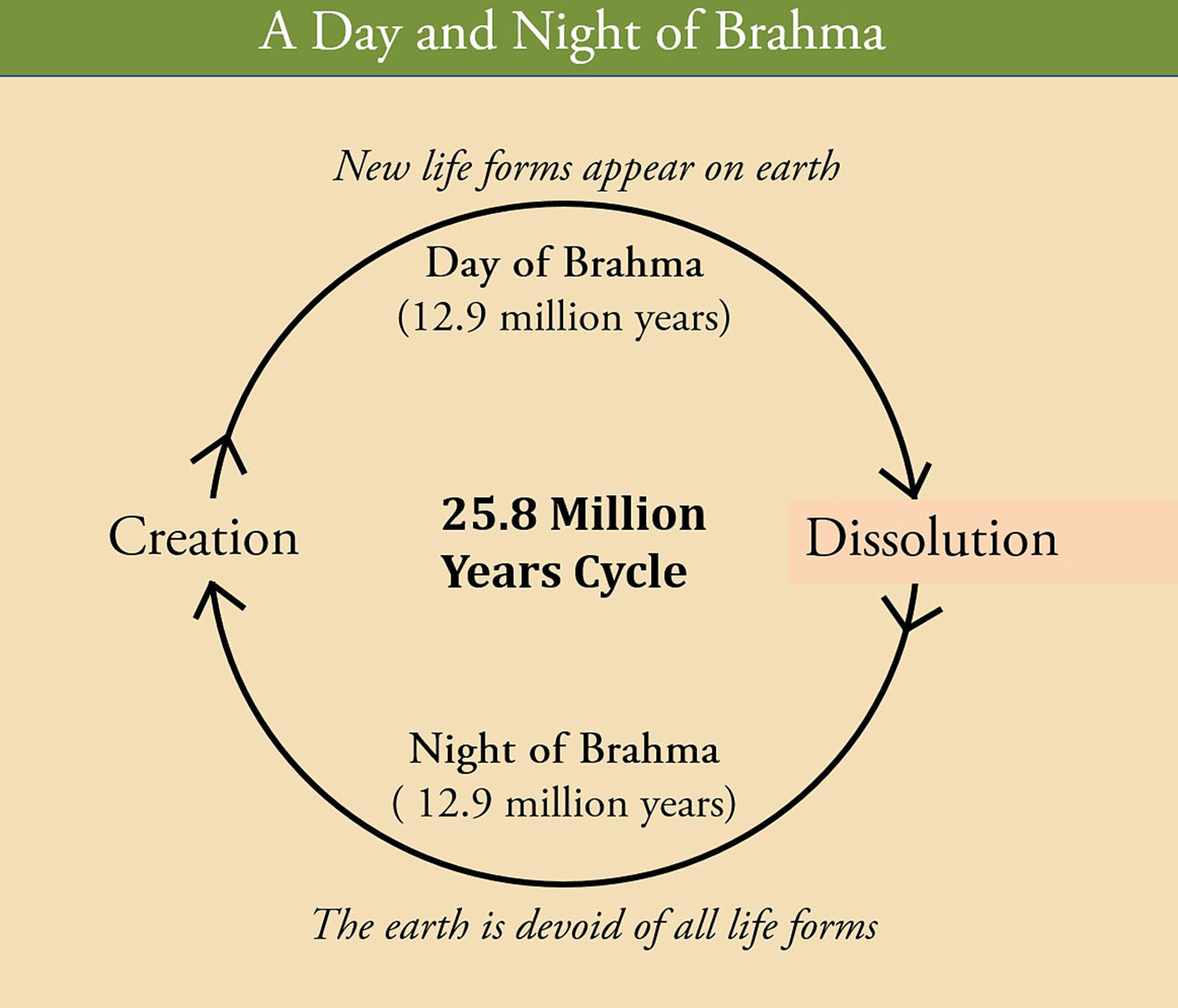
A “Day of Brahma”, subsequently, extends for 12.9 million years, throughout which era we expertise a protracted sequence of 500 full Yuga Cycles, and the earth is bustling with life and civilization. It’s adopted by a “Night time of Brahma” of equal period of 12.9 million years, when all life is snuffed out, and the whole world exits as an enormous, formless, lifeless ocean. Thus, the “Day and Night time of Brahma” is a grand cosmic cycle of creation and dissolution spanning over of 25.8 million years.
It’s simple to see that the time interval between two successive dissolution occasions on this cycle is 25.8 million years, which may be rounded off to 26 million years. Now, if a dissolution of life on a cosmic scale happens each 26 million years, shouldn’t this reality be mirrored within the fossil information of our planet?
Amazingly sufficient, that is precisely what has been indicated by latest paleontological proof: each 26 million years there’s a mass extinction of species on the earth!
Mass Extinction Cycle
Round 67 million years in the past, the earth seemed like a really totally different place. Huge dinosaurs stalked the panorama, whereas huge avian reptiles patrolled the skies. However, then, one thing catastrophic occurred, which modified issues nearly in a single day. Practically 66 million years in the past the earth went by a interval of fast loss of life, known as a mass extinction, when greater than 75% of all animal and plant species grew to become extinct. Scientists now have proof that the die-off was precipitated when an asteroid, about 10 kilometers in diameter, struck the earth at a velocity of about 20 km/sec and created the 200-km vast Chicxulub Crater in southeastern Mexico, releasing a billion instances extra power than the atomic bombs dropped on Hiroshima.
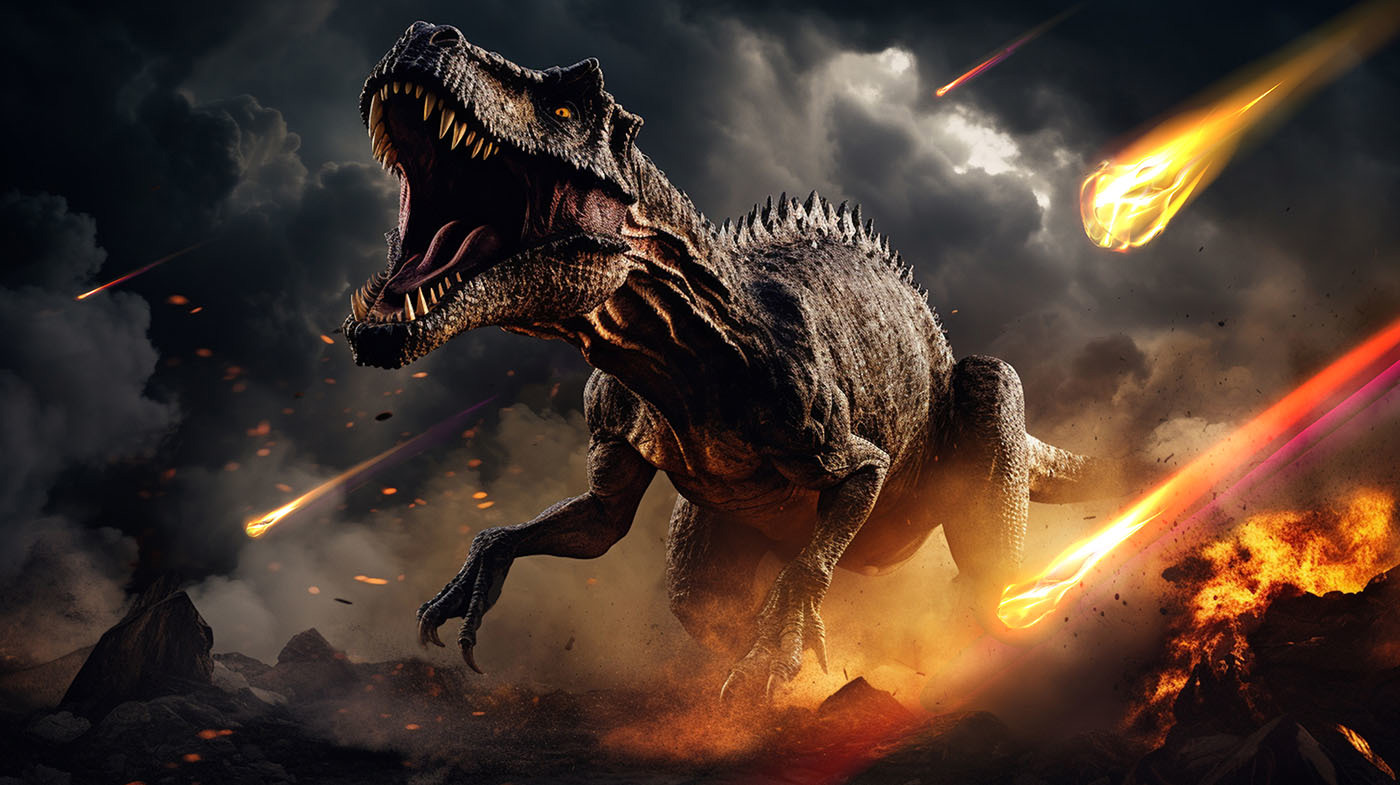
The influence generated scorching winds and shock waves, and ejected a big jet of molten materials, a number of instances hotter than the floor of the solar, which set fireplace to every part inside a thousand miles. Measurements of the layer of ash and soot that finally coated the Earth point out that fires consumed about seventy % of the world’s forests. The collision triggered highly effective earthquakes and spawned mega tsunamis, lots of of ft tall. A mannequin of the influence occasion developed by scientists at Los Alamos Nationwide Laboratory exhibits,
“The mud and soot from the influence and the conflagrations prevented all daylight from reaching the planet’s floor for months. Photosynthesis all however stopped, killing a lot of the flowers… After the fires died down, Earth plunged right into a interval of chilly, even perhaps a deep freeze. Earth’s two important meals chains, within the sea and on land, collapsed. About seventy-five % of all species went extinct. Greater than 99.9999 % of all dwelling organisms on Earth died, and the carbon cycle got here to a halt.”[3]
It’s to be famous right here that the influence occasion on the Ok-T boundary successfully killed off all of the dwelling organisms on our planet, regardless that the species die-off is estimated at roughly 75%. It is because a number of the species that existed at the moment, re-appeared within the fossil information at a later date, and subsequently, isn’t thought of to have gone extinct.
The fiery cataclysm that led to the extinction of the dinosaurs is in excellent alignment with the outline of the dissolution occasion that happens on the finish of a “Day of Brahma” when all life kinds on the earth are destroyed, and, because the Vishnu Purana states, “all of the three worlds, earth, and the areas of house are consumed with fireplace”. Admittedly, the traditional Vedic sages knew a factor or two in regards to the true historical past of our planet.
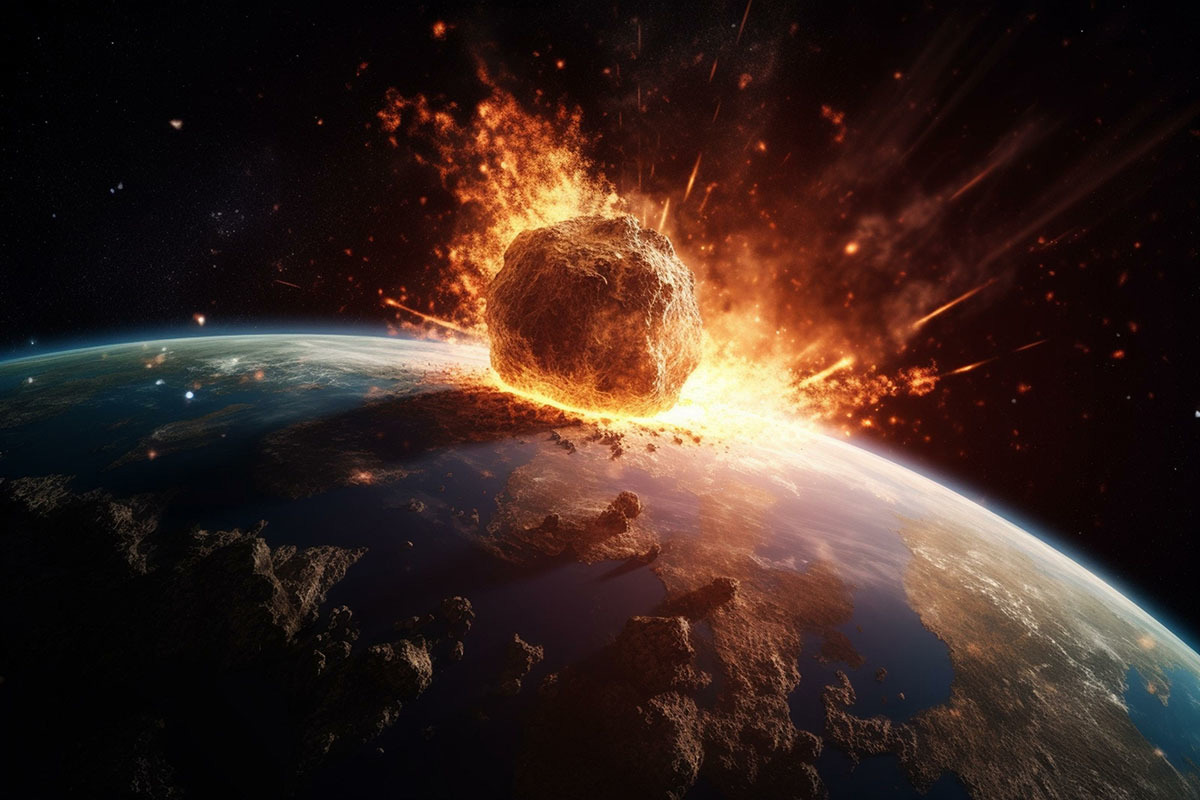
Furthermore, this isn’t the one mass extinction occasion that has occurred on our planet up to now. There are numerous extra, and, fairly surprisingly, they happen in a cyclical method each 26 million years!
In 1984, paleontologists David Raup and Jack Sepkoski of the College of Chicago recognized a 26-million-year periodicity in extinction charges over the previous 250 million years.[4] As a part of a broad research of the distribution of marine life by geologic time, Sepkoski had ready an inventory of a few quarter of 1,000,000 species of sea-dwelling creatures, each extinct and present, noting the time limit the place they appeared and have become extinct. The research was confined to marine organisms for the reason that probabilities of discovering fossils are a lot larger underneath the ocean. The oceans are areas of internet sedimentation, whereas land is an space of internet erosion.
David Raup, a senior colleague on the College of Chicago, steered to Sepkoski that he look at the checklist for any proof of a sample within the timing of the mass extinctions. Sepkoski determined to focus on the final 250 million years of geologic time and throw out animals whose actual timing of look and disappearance have been debated. He was left with about 500 of his authentic 3,500 marine households (250,000 species). Sepkoski put the info by a pc program and was shocked to search out that life kinds on Earth disappeared in nice numbers each 26 million years. Each of them checked for errors and confirmed the sample; life appeared to vanish drastically precisely each 26 million years. Of their seminal paper, Raup and Sepkoski wrote:
“The temporal distribution of the foremost extinctions over the previous 250 million years has been investigated statistically utilizing numerous types of time collection evaluation. The analyzed report is predicated on variation in extinction depth for fossil households of marine vertebrates, invertebrates, and protozoans, and comprises 12 extinction occasions. The 12 occasions present a statistically important periodicity (P <0.01) with a imply interval between occasions of 26 million years. Two of the occasions coincide with extinctions which were beforehand linked to meteorite impacts (terminal Cretaceous and late Eocene). Though the causes of the periodicity are unknown, it’s doable that they’re associated to extraterrestrial forces (photo voltaic, photo voltaic system, or galactic.)”
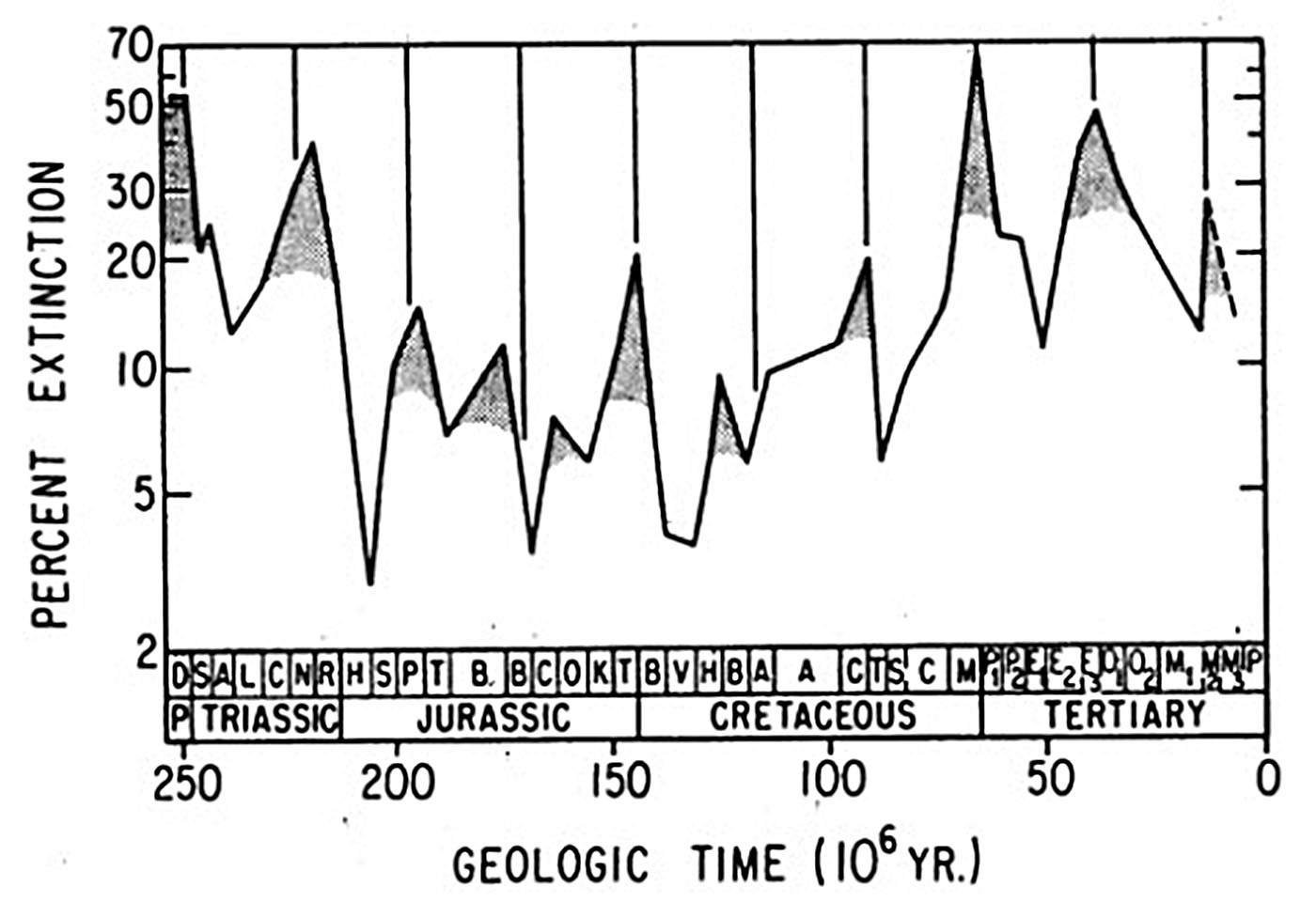
The mass extinction occasions should not selective in any respect, in the best way Darwin had proposed. As per Darwinism, the evolutionary course of is gradual, and life kinds evolve slowly by a means of pure choice, during which the inferior life kinds are eradicated since they’re much less suited to the wrestle for existence. Nonetheless, in case of a mass extinction, there isn’t any method of understanding beforehand which species will survive the extinction occasion and which can die out. The method is completely random. In a paper titled, “The Function of Extinction in Evolution” (1982), David Raup wrote,
“The most important mass extinctions produce main restructuring of the biosphere whereby some profitable teams are eradicated, permitting beforehand minor teams to broaden and diversify…There may be little proof that extinction is selective within the optimistic sense argued by Darwin. It has typically been inconceivable to foretell, earlier than the actual fact, which species will likely be victims of an extinction occasion.”[5]
The 26-million-year extinction cycle has, since then, been validated by numerous unbiased research. In 2010, Adrian Melott and Richard Bambach recognized a 27 Myr periodicity within the extinction knowledge, extending over the previous 500 million years. They wrote,
“We examined periodicities in extinction during the last 500 million years, and concluded {that a} sign detected by Raup & Sepkoski (1984) was current in higher resolved, extra in depth present knowledge, over an extended time interval than they’d initially claimed, and at the next stage of significance. The claimed interval grew from 26 to 27 Myr, and can also be now noticed to increase over the whole 500 million years interval fairly than simply the final 250 million years, because of revisions within the geological timescale for the reason that Nineteen Eighties.”[6]
Mass Extinctions and Impression Craters
It has change into fairly apparent over time that the first triggers for the mass extinctions are influence occasions. In 1980, the father-son duo of the Nobel Prize-winning physicist Luis Alvarez and his son, the geologist Walter Alvarez, had inferred that the sudden extinction of dinosaurs on the Ok-T (Cretaceous–Tertiary) boundary, practically 66 million years in the past, was because of the influence of a giant asteroid or comet.
Luis and Walter Alvarez had observed that sedimentary layers all around the world on the Ok-T boundary comprise a focus of iridium many instances higher than regular. Iridium is extraordinarily uncommon within the Earth’s crust however is considerable in chondritic meteorites and asteroids. Furthermore, the isotopic ratio of iridium in asteroids is just like that seen within the Ok–T boundary layer. Based mostly on this, the Alvarez crew steered that the iridium spike on the Ok-T boundary was of extraterrestrial origin and had settled out of a worldwide mud cloud triggered by the influence of an asteroid, no less than 10 km in diameter.
Whereas Alvarez’s concept was initially rejected by most paleontologists, the following discovery and courting of the Chicxulub Crater in Mexico validated their findings and silenced the dissenters.
Since then, different scientists have discovered that the estimated ages of numerous influence craters coincide with the mass extinction occasions.
Within the mid-Nineteen Eighties, cratering specialist Richard Grieve ran his checklist of well-dated influence craters by the pc at NASA’s Goddard Institute for House Research and recognized a crater periodicity of practically 30 million years. Across the identical time, Walter Alvarez and Richard Muller at UC Berkeley recognized a 28 million-year cycle utilizing a considerably totally different set of craters.
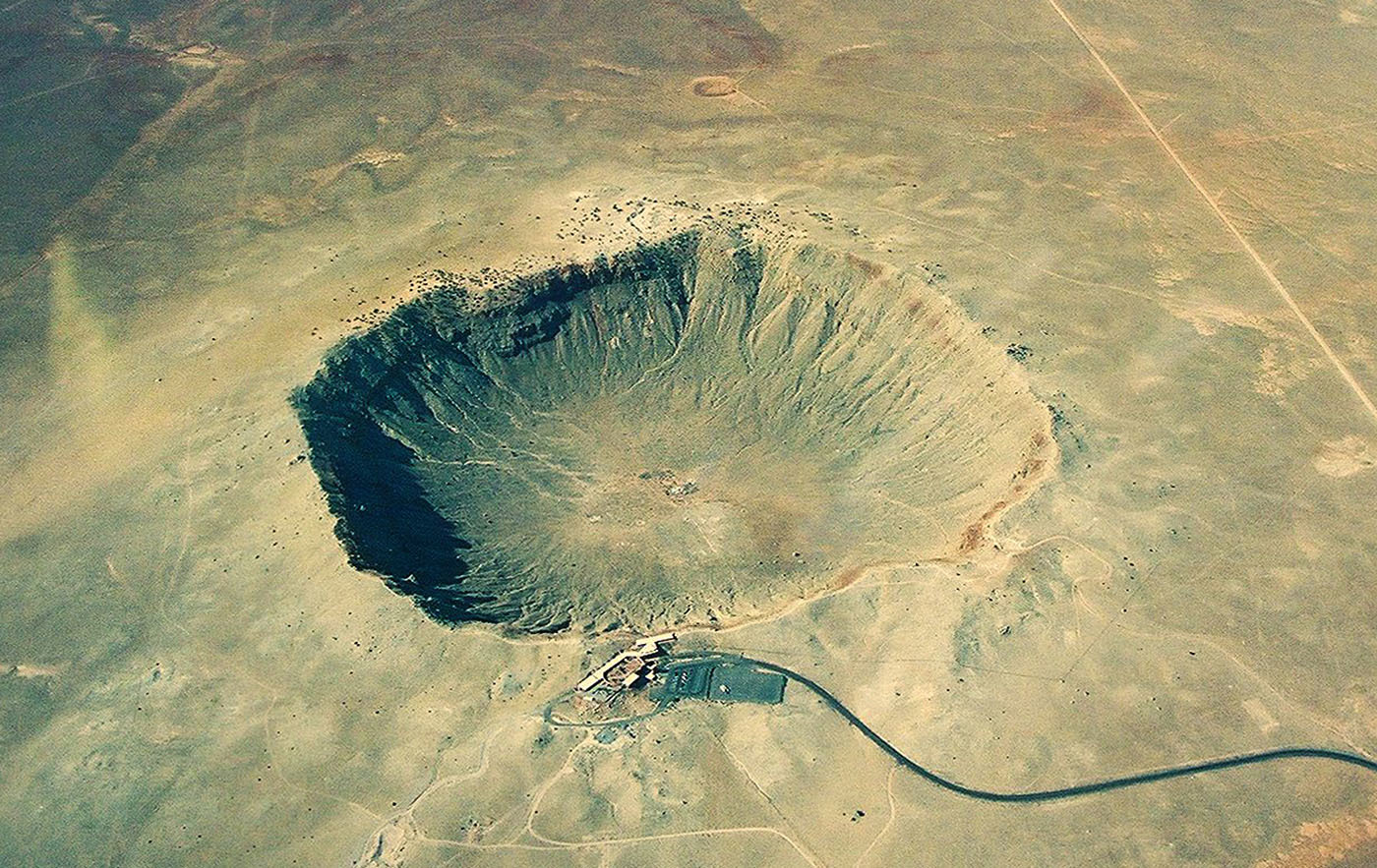
In 2015, Michael Rampino and his scholar Ken Caldeira studied extra influence craters with improved crater-age knowledge, and “discovered that craters and extinctions each appear to happen with the identical 26 million-year cycle”.[7] Crater formation fee peaks near the time of an extinction occasion, and a number of the largest influence craters have been shaped throughout an extinction occasion. Clearly, the 26 million-year extinction cycle is a big geological sign, which some scientists name the “geological heartbeat” of our planet.
It’s nothing wanting astonishing that, such exact details about the 26-million-year mass extinction cycle has been specified within the Vedic texts. After all, a few questions nonetheless have to be clarified. The Vedic doctrine claims that the earth stays completely devoid of all life kinds for the whole 12.9-million-year period of the “Night time of Brahma” that follows the extinction occasion. Do have any scientific proof in assist of this? Because it seems, there’s. And extra research are arriving on the identical conclusion.
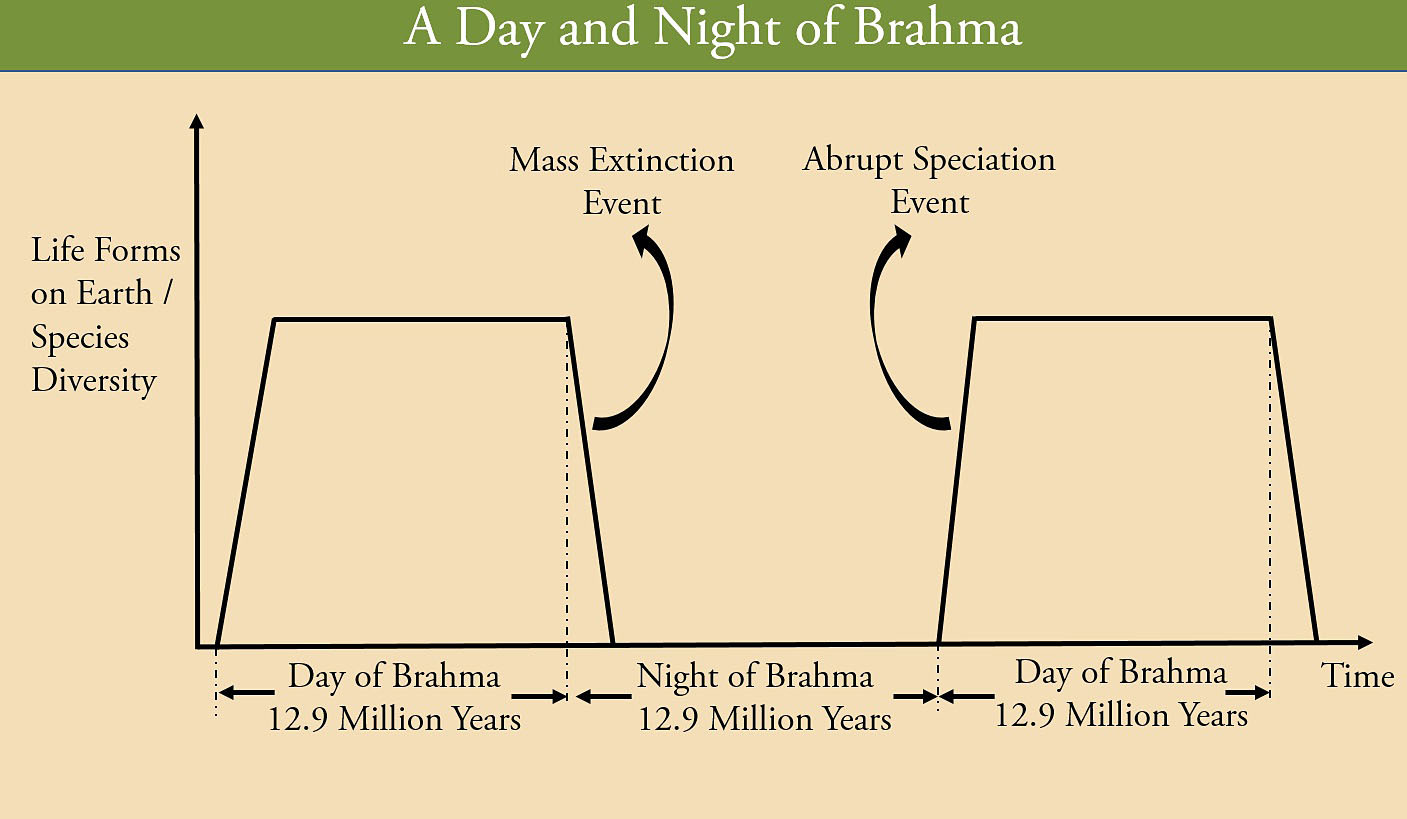
The Night time of Brahma
In Might 2012, an article in Nature Geoscience written by Dr. Zhong-Qiang Chen of the China College of Geosciences in Wuhan and Professor Michael Benton of the College of Bristol acknowledged that it took practically 10 million years for all times kinds to seem after the end-Permian mass extinction occasion 250 million years in the past, which had worn out practically 90% of all dwelling species.[8]
As per the scientists, two elements may have delayed the looks of latest life kinds: 1) the sheer depth of the disaster, and a couple of) the persevering with grim situations on earth after the primary wave of extinction.[9] Professor Michael Benton wrote that “on this most devastating case, life did get better, after many tens of millions of years, and new teams emerged. The occasion had re-set evolution.”[10]
One other research performed in 2019 discovered that it takes no less than ten million years earlier than the range of a species achieves the same stage to that seen earlier than the mass extinction occasion.[11] Dr. Lowery and Dr. Fraass studied foram fossils for a time interval masking roughly 20 million years, from the top of the Cretaceous mass extinction (66 million years in the past) and increasing by the following restoration, to find out how lengthy it took these minibeasts to get better their species variety. Dr. Lowery and Dr. Fraass concluded that it took no less than ten million years for foram species variety to get better.[12]
These research affirm that, generally, it takes round 10 million years or extra for all times kinds to emerge and world biodiversity to get better, after a mass extinction occasion. This confirms what Vedic sages mentioned in regards to the “Night time of Brahma” being a time when the earth is devoid of life kinds.
The opposite query that was on my thoughts is that this: As per the Vedic doctrine, life kinds come up in a short time after a “Night time of Brahma” ends, and the following “Day of Brahma” begins. Now, does this actually occur? Can we see a sudden emergence of life kinds after a mass extinction occasion, or do they seem regularly by a means of pure choice extending over tens of millions of years, as Darwin had proposed?
Punctuated Equilibrium
Darwin’s concept that new species come up by the gradual and regular transformation of whole populations isn’t mirrored within the fossil information. If this have been true, then a steady sequence of “intermediate kinds”, displaying incremental modifications on the best way to a brand new species, ought to have been discovered within the rock strata. Sadly, intermediate kinds connecting species have by no means been recognized. The absence of “lacking hyperlinks” had additionally involved Darwin, who attributed it to the imperfections of the geological report. Within the Origin of Species, Darwin wrote,
“Why then isn’t each geological formation and each stratum stuffed with such intermediate hyperlinks? Geology assuredly doesn’t reveal any such finely graduated natural chain; and this, maybe, is the obvious and gravest objection which may be urged in opposition to my concept.”[13]
“The geological report is extraordinarily imperfect and this reality will to a big extent clarify why we don’t discover interminable varieties, connecting collectively all of the extinct and present types of life by the best graduated steps. He who rejects these views on the character of the geological report will rightly reject my entire concept. ”[14]
In 1972, Harvard College paleontologists Stephen Jay Gould and Niles Eldredge wrote their seminal paper titled, “Punctuated Equilibria: an alternative choice to phyletic gradualism”, during which they argued that the fossil report isn’t imperfect, as claimed by Darwinists. The numerous breaks within the fossil information are actual, and so they specific how evolution happens. The absence of transitional kinds implies that evolution doesn’t happen by the gradual and gradual transformation of a species.
“Below the affect of phyletic gradualism, the rarity of transitional collection stays as our persistent bugbear…Many breaks within the fossil report are actual; they specific the best way during which evolution happens, not the fragments of an imperfect report. The sharp break in an area column precisely information what occurred in that space by time.”[15]
“Though phyletic gradualism prevails as an image for the origin of latest species in paleontology, only a few basic examples purport to doc it. A couple of authors have provided a easy a literal interpretation of this example: in-situ, gradual, progressive evolutionary change is a uncommon phenomenon. However we often clarify the paucity of circumstances by an almost ritualized invocation of the inadequacy of the fossil report.”[16]
Gould and Eldredge proposed the speculation of Punctuated Equilibrium to elucidate what is absolutely taking place within the fossil information. They mentioned that the fossil information present lengthy durations of stasis or equilibrium, extending for tens of millions of years, throughout which era there’s little or no evolutionary change, that are punctuated by fast, episodic durations of speciation, occurring throughout the house of some thousand years.
Gould supplied additional clarification in his article titled, “Evolution’s Erratic Tempo (1977)”, during which he wrote that, in any native space, “a species doesn’t come up regularly by the regular transformation of its ancestors; it seems all of sudden and totally shaped”[17]. As soon as a species seems, it undergoes little or no or no evolutionary change for tens of millions of years. Most species, “seem within the fossil report wanting a lot the identical as once they disappear; morphological change is often restricted and directionless.”[18]
Gould berated the paleontological neighborhood for being so closely influenced by Darwin’s concept of gradual evolution, that they didn’t discover the plain patterns within the fossil information.
“The acute rarity of transitional kinds within the fossil report persists because the commerce secret of paleontology…Paleontologists have paid an exorbitant worth for Darwin’s argument. We fancy ourselves as the one true college students of life’s historical past, but to protect our favored account of evolution by pure choice we view our knowledge as so unhealthy that we by no means see the very course of we profess to check.”[19]
Gould was some of the influential and extensively learn authors of in style science of his technology. He wrote 300 in style essays within the Pure Historical past journal, for each specialists and non-specialists. In April 2000, the US Library of Congress named him a “Dwelling Legend”. All through his profession, Gould insisted that the gradualistic fashions of evolution are merely not mirrored within the fossil information, and there’s a robust tendency throughout the scientific neighborhood to limit their pondering inside sure perception methods.
Within the essay, “Darwin’s Premature Burial” (1976), Gould gave vent to his frustration when he wrote, “I’m a powerful advocate of the final argument that “reality” as preached by scientists usually seems to be not more than prejudice impressed by prevailing social and political views.”[20]
In “The Return of Hopeful Monsters” (1977), he wrote that, “all paleontologists know that the fossil report comprises valuable little in the best way of intermediate kinds; transitions between main teams are characteristically abrupt.” Then, within the essay titled, “Is a New and Common Principle of Evolution Rising?” (1980), Gould reiterated the plain flaws within the Darwinian mannequin of evolution:
“The absence of fossil proof for middleman phases between main transitions in natural design, certainly our lack of ability, even in our creativeness, to assemble useful intermediates in lots of circumstances, has been a persistent and nagging drawback for gradualistic accounts of evolution.”[21]
The reality is that after we go purely by the fossil information – leaving apart all theories and speculations – what we see are fast bursts of speciation and never the long-drawn-out gradual accumulation of small variations.
Gould’s Harvard colleague, Niles Eldredge, estimated that the fast durations of evolutionary change, “took one thing between 5,000 and 50,000 years—a mere blink of a watch geologically talking.”[22]
It’s equally fascinating that this estimate may be very near the worth talked about within the Surya Siddhanta, which is the oldest astronomical treatise of India. The textual content states: “100 instances 4 hundred and seventy-four years handed whereas the All-Sensible was employed in creating the animate and inanimate creation, crops, stars, gods, demons and the remaining.”[23] This implies the whole artistic course of (presumably at first of the present Day of Brahma) took 47,400 years, which falls within the vary of values discovered by Eldredge i.e. between 5000 – 50,000 years.
Oscillations in Morphology
As soon as speciation is accomplished, each species stays amazingly secure for tens of millions of years. That doesn’t imply that they don’t change in any respect. In his research of Devonian trilobites, which lived between 380-375 million years in the past, Eldredge had discovered that, as soon as a brand new species appeared, they endured for tens of millions of years with little or no morphological change.
“There have been some oscillations in morphology, so species weren’t fully invariant, however the internet sum of any modifications often tended to cancel out, resulting in no internet change.”[24]
Gould, by the best way, had additionally discovered very comparable patterns in his research that targeted on fossil land snails from the genus Poecilozonites that lived a number of hundred thousand years in the past throughout the Pleistocene.[25]
I used to be amazed to know of those findings as a result of that is exactly what I had found in course of my explorations into the Yuga Cycle. In Yuga Shift, I had proposed, primarily based on ample knowledge factors, that, each human cranial quantity in addition to bodily measurement fluctuates in a sinusoidal method over a 25,800-year precession cycle, with no internet improve or lower in any route. I had additionally written that this oscillation will need to have been happening over the previous 2 million-odd years of human evolution.
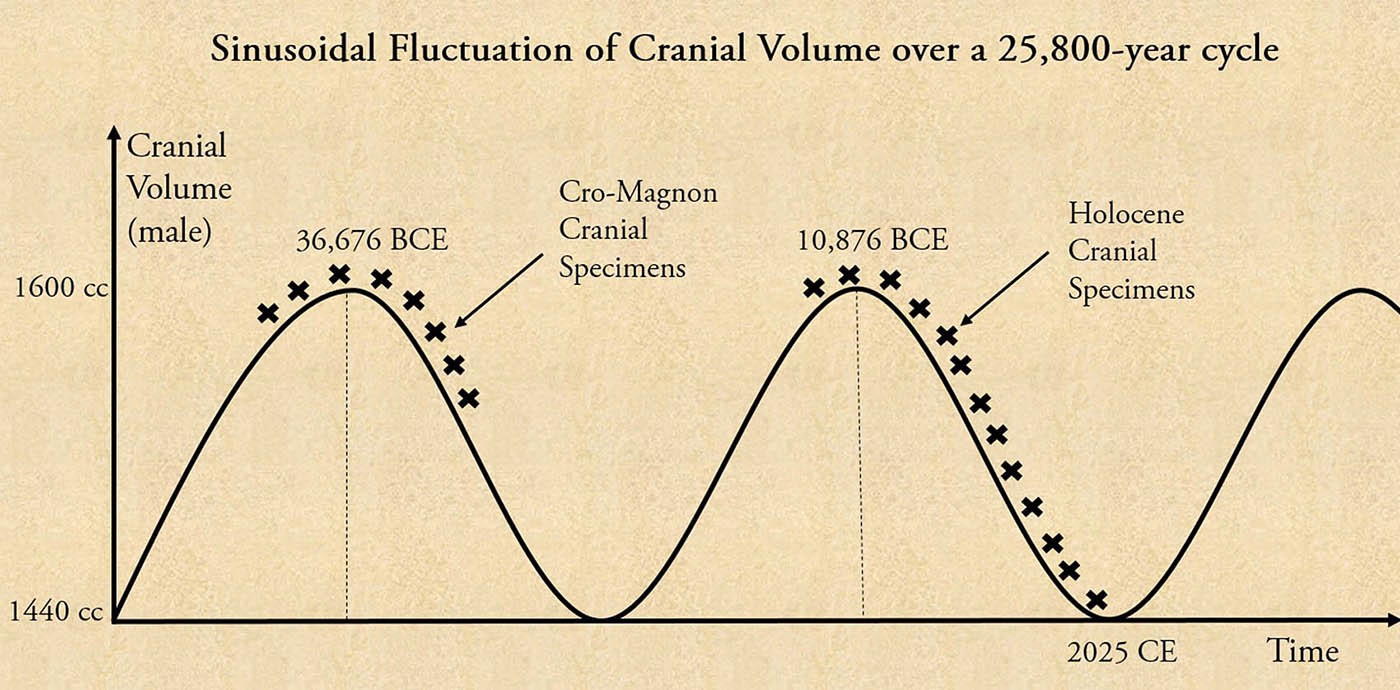
And now it seems that the “oscillations in morphology” happen not solely in case of people, however is a attribute function of the whole animal kingdom! All species improve and reduce in measurement and cranial capability in a sinusoidal method over the whole “Day of Brahma” of 12.9 million years, spanning 500 full Yuga Cycles! Because of this the Ice Age megafauna have been a lot greater than the animals of at present. It’s a recurring sample of nature.
Each assertion of the Vedic texts with respect to the “Day and Night time of Brahma” has now been detected within the fossil information. It’s not an approximate correlation, however an nearly actual match. Let me recapitulate the vital connections:
1. The fossil information present {that a} mass extinction of species happens each 26 million years, whereas the Vedic texts declare that every one life on the earth is extinguished on the finish of a “Day of Brahma”, each 26 million years.
2. The fossil information present that it takes 10 million years or extra for brand new life kinds to emerge and for world biodiversity to get better, after a mass extinction occasion. The Vedic texts declare that the earth stays in a dull state throughout the “Night time of Brahma”, which extends for 13 million years after an extinction occasion.
3. The fossil information present that new species seem in fast, episodic bursts, in a totally shaped state. The fast speciation occasions are accomplished inside 5,000 – 50,000 years. The Vedic texts declare that new life kinds come up on the earth as quickly as a brand new “Day of Brahma” dawns, and it takes practically 47,400 years for all dwelling entities to be created.
The fossil information are in excellent alignment with each component of the doctrine of the “Day and Night time of Brahma”. That is yet one more indication of the profound data of the huge time cycles that our ancestors had possessed, and so they handed them right down to us in easy verses, though, typically additionally they employed metaphors and symbolic imageries to drive house the purpose and support in memorization.
As an illustration, the occasions that happen in the midst of a “Day and Night time of Brahma” have additionally been metaphorically described because the “respiration out and in of Brahma”. When Brahma breathes out, life kinds get dispersed throughout the cosmos, and when he breathes in, life kinds return to the supply and the cosmos turns into lifeless. In Yuga Shift, I’ve proposed that the unmanifested, artistic precept, that the Vedic sages known as Brahma, refers back to the central black gap of the Milky Means galaxy, which, as most scientists agree, acts because the central engine of our galaxy.
When does the present Day of Brahma finish?
In case you might be questioning when the present “Day of Brahma” will come to a cataclysmic finish, you possibly can relaxation simple, for it’s nonetheless a really great distance off. The final mass extinction occasion was the “Center Miocene Disruption” which occurred round 14.8 Mya (Million years in the past). Which means that the present “Day of Brahma” began 12.9 Myr later, at round 1.9 Mya.
Not surprisingly, the earliest fossil stays of the genus Homo (to which our personal species Homo sapiens belongs) began showing across the identical time. The oldest hominin fossils are these of Homo habilis, dated to round 1.9 Mya. H. habilis cranial quantity fluctuated between 500 cc – 800 cc over the course of its presence within the fossil information until round 1.5 Mya. The bipedal, erect strolling, Homo erectus seems within the fossil information from 1.7 Mya until round 250,000 years in the past. H. erectus exhibits a fluctuation in cranial quantity between 850 – 1200 cc.
For the reason that present “Day of Brahma” began round 1.9 Mya, the following cosmic dissolution occasion is sort of 11.4 million years away. So we are able to safely take it off our calendar for now. It’s not cosmic dissolution that ought to fear us, however the impending transition out of the Kali Yuga in 2025, which is more likely to be very turbulent.
There isn’t any doubt that our ancestors had a really subtle understanding of the huge cycles of time that regulate life and civilization on our planet. Sadly, this knowledge was regularly forgotten, as we devolved alongside the descending arc of the Yuga Cycle. The scientific advances of the previous couple of centuries at the moment are serving to us to uncover the true significance of those historical doctrines. Nonetheless, generally, the perspective of scientists and teachers in the direction of the traditional cultures continues to stay dismissive. The issue is that, as soon as we change into indoctrinated with a selected perception system since childhood, it turns into extraordinarily troublesome to dislodge it, even with assistance from voluminous quantities of scientific knowledge. Until we undertake an perspective of respect in the direction of the traditional civilizations, we’ll proceed to stay oblivious to the grand shops of knowledge which were encoded into their sacred texts, symbols and sumptuous archaeological monuments.
References
[1] The Vishnu Purana 1.3, tr. by Horace Hayman Wilson, 1840, https://sacred-texts.com/hin/vp/vp037.htm
[2] The Bhagavad Gita 8.17-8.20 tr. Eknath Easwaran, Penguin Books, 1996.
[3] Douglas Preston, The Day the Dinosaurs Died, The New Yorker, 29 March 2019, https://www.newyorker.com/journal/2019/04/08/the-day-the-dinosaurs-died
[4] Raup and Sepkoski, Proc. Natl. Acad. Sci. USA, 81(1984): 801-805
[5] D M Raup, “The function of extinction in evolution”, PNAS 91 (1994): 6758-6763.
[6] Adrian L. Melott and Richard Ok. Bambach, “DO PERIODICITIES IN EXTINCTION—WITH POSSIBLE ASTRONOMICAL CONNECTIONS—SURVIVE A REVISION OF THE GEOLOGICAL TIMESCALE?”, The Astrophysical Journal, 2013, Quantity 773, #1
[7] Michael R. Rampino, “Darkish matter’s shadowy impact on Earth”, Astronomy.com July 31, 2019, https://astronomy.com/journal/2019/07/dark-matters–shadowy-effect–on-earth
[8] Zhong-Qiang Chen, Michael J. Benton, “The timing and sample of biotic restoration following the end-Permian mass extinction” Nature Geoscience, 2012, DOI: 10.1038/ngeo1475
[9] College of Bristol, “It took Earth ten million years to get better from best mass extinction” ScienceDaily, 27 Might 2012, www.sciencedaily.com/releases/2012/05/120527153810.htm
[10] Ibid
[11] Christopher M. Lowery and Andrew J. Fraass, “Morphospace enlargement paces taxonomic diversification after finish Cretaceous mass extinction”, Nature Ecology & Evolution, 9 April 2019, DOI:10.1038/s41559-019-0835-0
[12] GrrlScientist, “Look Of New Species After Mass Extinction Has Evolutionary ‘Pace Restrict’”, Forbes Apr 13, 2019, https://www.forbes.com/websites/grrlscientist/2019/04/13/appearance-of-new-species-after-mass-extinction-has-evolutionary-speed-limit/?sh=7a3c6dfa525b
[13] Charles Darwin, Origin of Species (1859) 280
[14] Charles Darwin, Origin of Species (1859) 342
[15] Gould, S. J. and Eldredge, N., “Punctuated equilibria: an alternative choice to phyletic gradualism” Fashions in paleobiology ed. Schopf, TJM Freeman (San Francisco: Cooper & Co, 1972) pp. 82-115
[16] Ibid
[17] Ibid
[18] Gould, S.J, “Evolution’s Erratic Tempo”, Pure Historical past 86 (1977): 14
[19] Gould, S. J., 1977, “Evolution’s erratic tempo” Pure Historical past, 86(1977):14
[20] Stephen Jay Gould, “Darwin’s Premature Burial,” Pure Historical past 85 (1976): 24-30
[21] Gould, S. J , “Is a brand new and normal concept of evolution rising?” Paleobiology 6 (1980):119–130.
[22] Eldredge, N. The Early “Evolution” of “Punctuated Equilibria”. Evo Edu Outreach 1, 107–113 (2008). https://doi.org/10.1007/s12052-008-0032-0
[23] Surya-Siddhanta: A text-book of Hindu astronomy, trans. Ebenezer Burgess, Phanindralal Gangooly (Motilal Banarsidass Publ., 1989) chapter 1, p 13.
[24] “Punctuated equilibrium and stasis”, Digital Atlas of Historical Life, Paleontological Analysis Establishment, https://www.digitalatlasofancientlife.org/study/evolution/punctuated-equilibrium-and-stasis/
[25] “Punctuated equilibrium and stasis”, Digital Atlas of Historical Life, Paleontological Analysis Establishment, https://www.digitalatlasofancientlife.org/study/evolution/punctuated-equilibrium-and-stasis/
